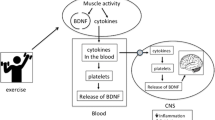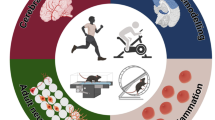Abstract
This article reviewed the beneficial effects of moderate voluntary physical exercise on brain health according to the studies on humans and animals, which includes improving psychological status and cognitive function, enhancing psychological well-being, decreasing the risks of Alzheimer’s disease (AD) and dementia, and promoting the effects of antidepressant and anxiolytic. The possible underlying neurobiological mechanisms are involved up-active and down-active pathways. The up-active pathway is associated with enhancements of several neurotransmitters systems afferent to hippocampus, including norepinephrine (NE), serotonin (5-Hydroxytryptamine, 5-HT), acetylcholine (ACh) and γ-aminobutyric acid (GABA). The down-active pathway is mainly concerned with up-regulation of the brain-derived neurotrophic factor (BDNF) and neurogenesis. It is suggested that NE activation via β-adrenergic receptors may be essential for exercise-induced BDNF up-regulation. The possible intracellular signaling pathways of NE-mediated BDNF up-expression may be involved in GPCR-MAPK-PI-3K crosstalk and positive feedback.
摘要
本文综述了在人和动物方面有关自愿适量运动有益于脑作用的研究, 包括改善心理状态和认知功能、 增强心理幸福感、 降低老年痴呆症发生危险度和发挥抗抑郁及抗焦虑药的作用等。 运动对脑的作用机制包含上游和下游 两方面: 上游途径主要涉及投射到海马的几种神经递质系统的功能增强, 其中包括去甲肾上腺素、5-羟色胺、 乙 酰胆碱和γ-氨基丁酸; 下游途径主要涉及脑源性神经营养因子的表达提高和神经元发生的增强; 其中, 激活 β 受 体介导的去甲肾上腺素能神经的传递被认为是运动导致脑源性神经营养因子表达增强的前提, 上述过程在细胞内的可能信号转导机制主要涉及G-蛋白偶联受体-促分裂原活化蛋白激酶-磷脂酰肌醇(−3)激酶等细胞信号转导通路的交互及正反馈调控。
Similar content being viewed by others
References
Dishman RK, Berthoud HR, Booth FW, Cotman CW, Edgerton VR, Fleshner MR, et al. Neurobiology of Exercise. Obesity (Silver Spring) 2006, 14: 345–356.
DiLorenzo TM, Bargman EP, Stucky-Ropp R, Brassington GS, Frensch PA, LaFontaine T. Long-term effects of aerobic exercise on psychological outcomes. Prev Med 1999, 28: 75–85.
Hassmén P, Koivula N, Uutela A. Physical exercise and psychological well-being: a population study in Finland. Prev Med 2000, 30: 17–25.
Netz Y, Wu MJ, Becker BJ, Tenenbaum G. Physical activity and psychological well-being in advanced age: a meta-analysis of intervention studies. Psychol Aging 2005, 20: 272–284.
Colcombe S, Kramer AF. Fitness effects on the cognitive function of older adults: a meta-analytic study. Psychol Sci 2003, 14: 125–130.
Salmon P. Effects of physical exercise on anxiety, depression and sensitivity to stress: a unifying theory. Clin Psychol Rev 2001, 21: 33–61.
Friedland RP, Fritsch T, Smyth KA, Koss E, Lerner AJ, Chen CH, et al. Patients with Alzheimer’s disease has reduced activities in midlife compared with healthy control-group members. Proc Natl Acad Sci USA 2001, 98: 3440–3445.
Laurin D, Verreault R, Lindsay J, MacPherson K, Rockwood K. Physical activity and risk of cognitive impairment and dementia in elderly persons. Arch Neurol 2001, 58: 498–504.
Paul AA, Victoria MP, Viorela P. Voluntary Exercise decreases amyloid load in a transgenic model of Alzheimer’s disease. J Neurosci 2005, 25: 4217–4221.
Neeper SA, Gómez-Pinilla F, Choi J, Cotman C. Exercise and brain neurotrophins. Nature 1995, 373: 109.
Oliff HS, Berchtold NC, Isackson P, Cotman CW. Exercise-induced regulation of brain-derived neurotrophic factor (BDNF) transcripts in the rat hippocampus. Brain Res Mol Brain Res 1998, 61: 147–53.
Antonio AG, Tony GH, Celithelma G, Chen MJ, Russo-Neustadt AA. Exercise antidepressant treatment and BDNF mRNA expression in the aging brain. Pharmacol Biochem Behav 2004, 77: 209–220.
Cotman CW, Berchtold NC. Exercise: a behavioral intervention to enhance brain health and plasticity. Trends Neurosci 2002, 25: 295–301.
Duman RS, Monteggia LM. A neurotrophic model for stress-related mood disorders. Biol Psychiatry 2006, 59: 1116–1127.
Duman RS. Neurotrophic factors and regulation of mood: role of exercise, diet and metabolism. Neurobiol Aging 2005, 26 Suppl 1: 88–93.
Farmer J, Zhao X, Van PH, Wodtke K, Gage FH, Christie BR. Effects of voluntary exercise on synaptic plasticity and gene expression in the dentate gyrus of adult male Sprague-dawley rats in vivo. Neuroscience 2004, 124: 71–79.
van Praag H, Shubert T, Zhao C, Gage FH. Exercise enhances learning and hippocampal neurogenesis in aged mice. J Neurosci 2005, 25: 8680–8685.
Dunn AL, Reigle TG, Youngstedt SD, Armstrong RB, Dishman RK. Brain norepinephrine and metabolites after treadmill training and wheel running in rats. Med Sci Sports Exerc 1996, 28: 204–209.
Sarbadhikari SN, Saha AK. Moderate exercise and chronic stress produce counteractive effects on different areas of the brain by acting through various neurotransmitter receptor subtypes: a hypothesis. Theor Biol Med Model 2006, 23: 33–43.
Garcia C, Chen MJ, Garza AA, Cotman CW, Russo-Neustadt AA. The influence of specific noradrenergic and serotonergic lesions on the expression of hippocampal BDNF transcripts following voluntary physical activity. Neuroscience 2003, 119: 721–732.
Mark PM, Atuart M, Bronwen M. BDNF and 5-HT: a dynamic duo in age-related neuronal plasticity and neurodegenerative disorders. Trends Neurosci 2004, 27: 589–594.
Chen MJ, Nguyen TV, Pike CJ, Russo-Neustadt AA. Norepinephrine induces BDNF and activates the PI-3K and MAPK cascades in embryonic hippocampal neurons. Cell Signal 2007, 19: 114–128.
Gobbi G, Blier P. Effect of neurokinin-1 receptor antagonists on serotoninergic, noradrenergic and hippocampal neurons: Comparison with antidepressant drugs. Peptides 2005, 26: 1383–1393.
Ivy AS, Rodriguez G, Garcia C, Chen MJ, Russo-Neustadt AA. Noradrenergic and serotonergic blockade inhibits BDNF mRNA activation following exercise and antidepressant. Pharmacol Biochem Behav 2003, 75: 81–88.
Xu CX, Liu HT, Wang J. Changes of 5-hydroxytryptamine and tryptophan hydroxylase expression in the ventral horn of spinal cord. Neurosci Bull 2008, 24: 29–32.
Author information
Authors and Affiliations
Corresponding author
Rights and permissions
About this article
Cite this article
Ma, Q. Beneficial effects of moderate voluntary physical exercise and its biological mechanisms on brain health. Neurosci. Bull. 24, 265–270 (2008). https://doi.org/10.1007/s12264-008-0402-1
Received:
Published:
Issue Date:
DOI: https://doi.org/10.1007/s12264-008-0402-1




